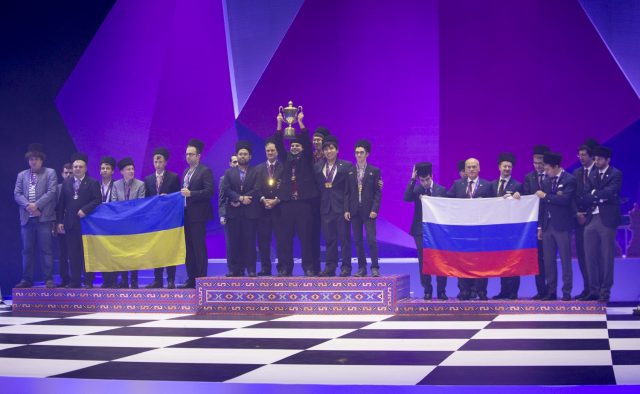 The US Team winning gold on the Olympic podium along with the silver and bronze winners, Ukraine and Russia. Photo: Maria Emelianova, Olympiad Website
The US Team winning gold on the Olympic podium along with the silver and bronze winners, Ukraine and Russia. Photo: Maria Emelianova, Olympiad WebsiteFor the first time in 40 years, the US has won gold at the Olympiad. How did they do it? Here’s a look at some of the stunning tactics from their games.
Board 1: Fabiano Caruana
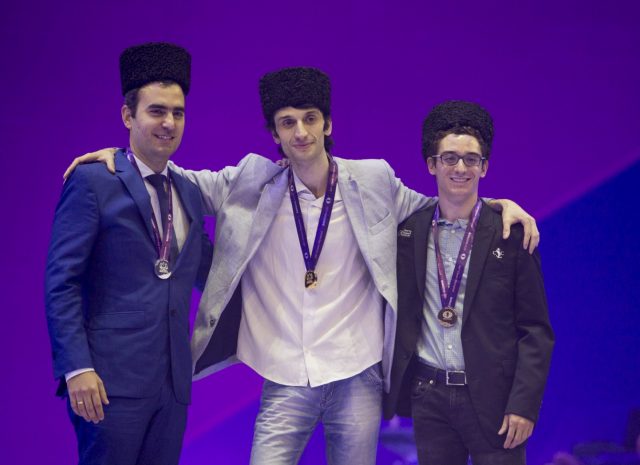 Board 1 bronze medalist, Fabiano Caruana (right), with the gold and silver winners, Baadur Jobava (center) and Perez Leinier Dominguez ( left). Photo: Maria Emelianova, Olympiad Website
Board 1 bronze medalist, Fabiano Caruana (right), with the gold and silver winners, Baadur Jobava (center) and Perez Leinier Dominguez ( left). Photo: Maria Emelianova, Olympiad WebsiteUS Champion, Fabiano Caruana, led the team as a very dependable Board 1, including a key victory over Pavel Eljanov to seal an American win against Ukraine, their main competitor throughout the event. Going undefeated and consistently maintaining an above 2800 performance rating, Caruana took home the Bronze medal for Board 1.
Tactic #1
Fabiano Caruana vs. Evgeny Bareev
White to move.
Level: Warm-Up
[pgn][Event "Chess Olympiad"] [Date "2016.09.13"] [Round "11"] [White "Fabiano Caruana"] [Black "Evgeny Bareev"] [Result "1-0"] [ECO "B12"] [SetUp "1"] [FEN "1k2bn1r/qpb5/p4Pnr/P2pP1p1/3N2B1/1NP1Q1B1/5R1P/R6K w - - 0 31"] [PlyCount "15"] [EventDate "2016.??.??"] 31. f7 $1 {White's passed pawns come rolling down the board. Black resigned. If } Bc6 (31... Bd7 32. e6 Bc8 33. Bxc7+ Kxc7 34. Nb5+) 32. e6 Bxg3 33. Qxg3+ Ka8 34. e7 Nxe7 35. Re1 Nfg6 36. Rxe7 {wins material:} Nxe7 37. f8=Q+ Rxf8 38. Rxf8+ 1-0[/pgn]
Board 2: Hikaru Nakamura
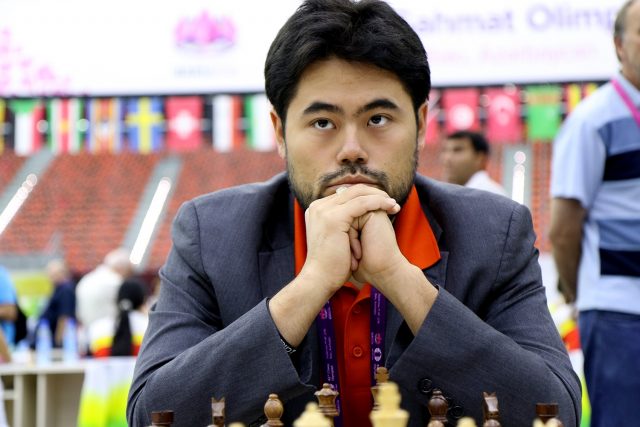 Hikaru Nakamura. Photo: Eteri Kublashvili, Olympiad Website
Hikaru Nakamura. Photo: Eteri Kublashvili, Olympiad WebsiteHikaru Nakamura was the only US Team member who played all 11 rounds of the Olympiad. He finished as the 5th highest Board 2 performance, winning 5 crucial games, many of which sealed team victories.
Tactic #2
Hikaru Nakamura vs. Robert Markus
White to move.
Level: Intermediate
[pgn] [Event "Chess Olympiad"] [Site "Baku AZE"] [Date "2016.09.06"] [Round "5.3"] [White "Hikaru Nakamura"] [Black "Robert Markus"] [Result "1-0"] [ECO "B42"] [WhiteElo "2789"] [BlackElo "2662"] [SetUp "1"] [FEN "3qrbk1/1b1n4/pp1pp1p1/4n2p/P2BPN2/1N1BQ2P/1PP3P1/R5K1 w - - 0 22"] [PlyCount "7"] [EventDate "2016.09.02"] 22. Nxg6 $1 {Black's position collapses. Markus resigned. If} Nxg6 23. Qg3 Nde5 (23... Kh7 24. e5 $1 Ndxe5 25. Bxe5 dxe5 26. Qxg6+) 24. Bxe5 dxe5 25. Qxg6+ { when Black's open king and White's extra pawn give White a winning advantage.} 1-0[/pgn]
Board 3: Wesley So
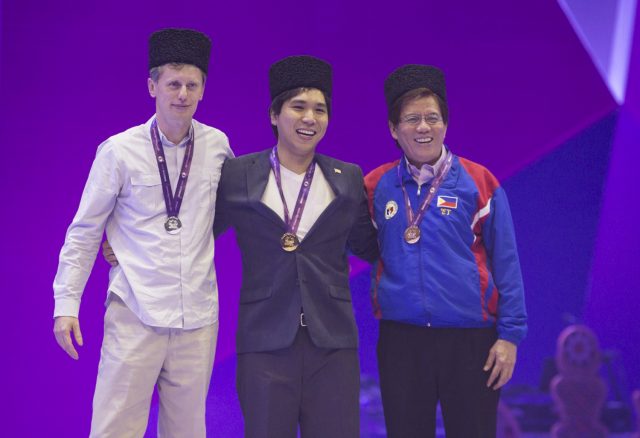 Board 3 gold medalist, Wesley So (center), with the silver and bronze winners, Zoltan Almasi (left) and Eugenio Torre (right). Photo: Maria Emelianova, Olympiad Website
Board 3 gold medalist, Wesley So (center), with the silver and bronze winners, Zoltan Almasi (left) and Eugenio Torre (right). Photo: Maria Emelianova, Olympiad WebsiteWesley So achieved an incredible 7 victories at the Olympiad, finishing with an undefeated 8.5 points out of 10. He won the gold medal for Board 3 with a 2896 performance rating.
Tactic #3
Wesley So vs. Aleksandr Lesiege
In this critical last round game against the Canadian team, Lesiege played 34...Qe5, counting on the rook to be indirectly defended because of 35. fxe3 Qg3 with a deadly checkmate threat on g2. What did he overlook?
White to move.
Level: Advanced
[pgn][Event "Chess Olympiad"] [Site "Baku AZE"] [Date "2016.09.13"] [Round "11.1"] [White "Wesley So"] [Black "Alexandre Lesiege"] [Result "1-0"] [ECO "A30"] [WhiteElo "2782"] [BlackElo "2512"] [SetUp "1"] [FEN "8/2N2pk1/6pp/2PPq3/8/4r2P/4rPP1/2Q2RK1 w - - 0 35"] [PlyCount "11"] [EventDate "2016.09.02"]35. fxe3 $1 {Wesley So bravely falls into his opponent's "trap".} Qg3 36. Qa1+ {and, realizing that he gets checkmate first, Black resigned:} Kg8 (36... Kh7 37. Rxf7+) (36... Kf8 37. Qa8+ Ke7 38. Qe8#) 37. Qa8+ Kg7 38. Ne6+ fxe6 39. Qf8+ Kh7 40. Rf7# 1-0[/pgn]
Board 4: Sam Shankland
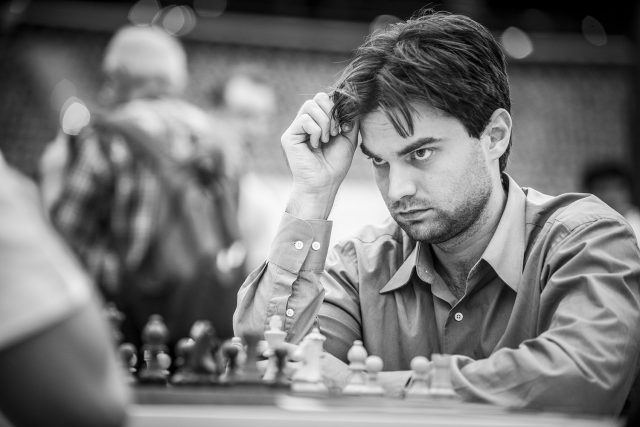 Sam Shankland. Photo: David Llada
Sam Shankland. Photo: David LladaSam Shankland was a very reliable 4th Board, winning key games for the team during rounds 9 and 10 against the tough teams, Norway and Georgia. He also played a role in the US team's convincing 3.5 to 0.5 victory over India.
Tactic #4
San Shankland vs. S.P. Sethuraman
In this infamous game from the match against India, Shankland fights back from a losing position--with computer evaluations as bleak as -9.5. When interviewed afterwards by Chess.com, Shankland shared his thought process during the game: "I wanted to resign, but I didn't. At some point, I stopped calculating. I just tried to play a move that didn't lose each time." In the position below, Sethuraman just made a mistake, 34...Rab2, how did Shankland fight back?
White to move.
Level: Intermediate
[pgn][Event "Chess Olympiad"] [Site "Baku AZE"] [Date "2016.09.09"] [Round "7.1"] [White "Samuel Shankland"] [Black "Sethuraman P Sethuraman"] [Result "1-0"] [ECO "D12"] [WhiteElo "2679"] [BlackElo "2640"] [SetUp "1"] [FEN "8/3Rbqk1/4p3/1B1p1p2/2nP1P2/2PKP3/1r4r1/1R1QB3 w - - 0 35"] [PlyCount "82"] [EventDate "2016.09.02"]35. Bxc4 {Trading off one of Black's key attacking pieces.} dxc4+ 36. Kxc4 { Although the king is completely out in the open, precise calculation shows that white doesn't get checkmated.} Qe8 ({If} 36... e5+ 37. d5 Qf6 38. Rxb2 Qa6+ (38... Rxb2 39. Qa1 Rb8 40. Qa7) 39. Rb5 Qc8+ 40. Kb3 Qxd7 41. c4) 37. Rxb2 {Each exchange favors White, who is 2 pawns ahead.} Rxb2 38. Qa1 { Activating the queen while gaining time by attacking the rook and chasing it from the strong attacking post, the b2 square.} Rb8 39. Qa7 {when White's active pieces keep his king from danger and put pressure on Black's position. White's extra pawns will eventually win the game. The game finished with:} Kf8 40. Kd3 Ra8 41. Qb7 Rb8 42. Qh1 Qxd7 43. Qh8+ Kf7 44. Qxb8 Qc6 45. Qb2 Qe4+ 46. Kd2 Qg2+ 47. Kc1 Qf1 48. Kd1 Qd3+ 49. Qd2 Qc4 50. Qe2 Qa4+ 51. Qc2 Qc4 52. Kd2 Qf1 53. Qd3 Qh1 54. Qe2 Qe4 55. Qh2 Qb7 56. Ke2 Qb2+ 57. Bd2 Qb5+ 58. Kf2 Kg6 59. Qg2+ Kf7 60. Qf3 Bh4+ 61. Kg2 Qd3 62. Qh5+ Kf8 63. Qd1 Kg7 64. Qg1 Qxd2+ 65. Kh3+ Kf8 66. Kxh4 Qxc3 67. Kh5 Qc6 68. Kh6 Qf3 69. Qg7+ Ke8 70. Qe5 Kd7 71. Kg7 Qg4+ 72. Kf8 Qh4 73. Qg7+ Kd6 74. Ke8 Qh5+ 75. Qf7 Kd5 1-0[/pgn]
Reserve: Ray Robson
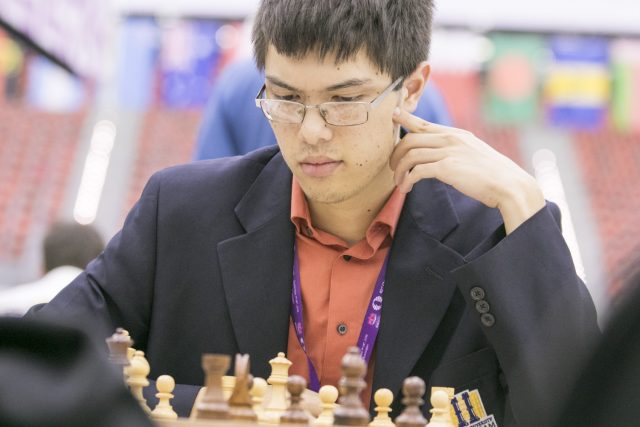 Ray Robson. Photo: Maria Emelianova, Olympiad Website
Ray Robson. Photo: Maria Emelianova, Olympiad WebsiteThe youngest player on the team, Ray Robson, finished the event with a respectable 3 points out of 5.
Tactic #5
Ray Robson vs. Iain Gourlay
White to move.
Level: Intermediate
[pgn][Event "Chess Olympiad"] [Site "Baku AZE"] [Date "2016.09.03"] [Round "2.2"] [White "Ray Robson"] [Black "Iain Gourlay"] [Result "1-0"] [ECO "C77"] [WhiteElo "2674"] [BlackElo "2393"] [SetUp "1"] [FEN "4r3/1b1nrp1k/pq1p2pp/3P4/1P1NP3/6NP/1P1QRPP1/4R1K1 w - - 0 32"] [PlyCount "13"] [EventDate "2016.09.02"]32. Ngf5 $1 {Targeting the weak h6-pawn. Black resigned. If} gxf5 (32... g5 33. Nxe7) 33. Nxf5 f6 34. Qxh6+ Kg8 35. Re3 Rh7 36. Qg6+ Kf8 37. Rg3 {and Black soon gets checkmated on g8 or if} Rh8 (37... Bxd5 38. Qxh7) 38. Qg7# 1-0[/pgn]
US Women's Team
Although the US Women's team ultimately did not finish on the podium, they achieved some impressive results throughout the event, including a victory against the highly ranked Russian team and a draw against the strong Indian team.
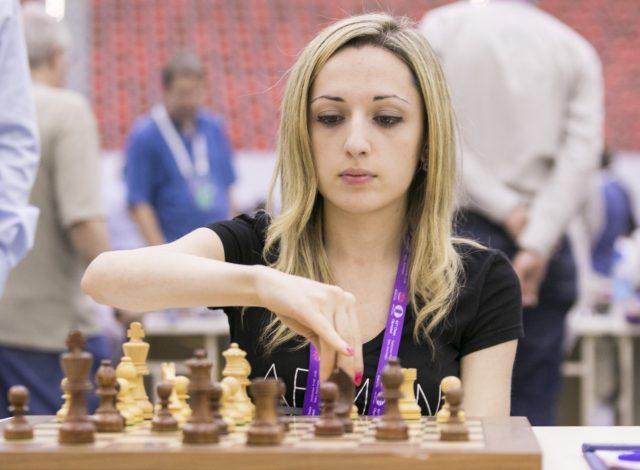 Nazi Paikidze. Photo: Maria Emelianova, Olympiad Website
Nazi Paikidze. Photo: Maria Emelianova, Olympiad WebsiteHere is a tactic by the US Women's Champion, Nazi Paikidze, who debuted at the Olympiad as the US Women's team Board 2.
Tactic #6
Olga Dolzhikova vs. Nazi Paikidze
Black to move.
Level: Advanced
[pgn][Event "Chess Olympiad (Women)"] [Site "Baku AZE"] [Date "2016.09.03"] [Round "2.7"] [White "Olga Dolzhikova"] [Black "Nazi Paikidze"] [Result "0-1"] [ECO "B11"] [WhiteElo "2167"] [BlackElo "2366"] [SetUp "1"] [FEN "2kr3r/pp3pp1/2p1p2p/q1bnP3/3P1PP1/1Pp4P/P1P1N2R/K2RQB2 b - - 0 20"] [PlyCount "11"] [EventDate "2016.09.02"]20... Ne3 $1 {Double attacking the c2 pawn and the white rook.} 21. Rc1 (21. Qxc3 Qxc3+ 22. Nxc3 Nxd1 23. Nxd1 Rxd4 {wins}) 21... Qa3 {and White resigned:} 22. Nxc3 (22. Qxc3 Bxd4 $1 23. Nxd4 Qxc1#) (22. Rb1 Nxc2#) 22... Bb4 23. Nb5 ( 23. Qxe3 Bxc3+ 24. Qxc3 Qxc1#) (23. Kb1 Nxf1 24. Qxf1 Bxc3) 23... Bxe1 24. Nxa3 Nxf1 25. Rxe1 (25. Re2 Bc3+ 26. Kb1 Nd2+) 25... Nxh2 {and Black is a rook ahead.} 0-1[/pgn]
For results and more information, visit the Official Olympiad Website. Also find the press release here and look for a post-tournament wrap-up by IM John Donaldson coming soon. Thanks to the Chess Club & Scholastic Center of St. Louis and to the Kasparov Chess Foundation for their continued generous support.
Categories
Archives
- April 2024 (35)
- March 2024 (34)
- February 2024 (25)
- January 2024 (26)
- December 2023 (29)
- November 2023 (26)
- October 2023 (38)
- September 2023 (27)
- August 2023 (37)
- July 2023 (47)
- June 2023 (33)
- May 2023 (37)
- April 2023 (45)
- March 2023 (37)
- February 2023 (28)
- January 2023 (31)
- December 2022 (23)
- November 2022 (32)
- October 2022 (31)
- September 2022 (19)
- August 2022 (39)
- July 2022 (32)
- June 2022 (35)
- May 2022 (21)
- April 2022 (31)
- March 2022 (33)
- February 2022 (21)
- January 2022 (27)
- December 2021 (36)
- November 2021 (34)
- October 2021 (25)
- September 2021 (25)
- August 2021 (41)
- July 2021 (36)
- June 2021 (29)
- May 2021 (29)
- April 2021 (31)
- March 2021 (33)
- February 2021 (28)
- January 2021 (29)
- December 2020 (38)
- November 2020 (40)
- October 2020 (41)
- September 2020 (35)
- August 2020 (38)
- July 2020 (36)
- June 2020 (46)
- May 2020 (42)
- April 2020 (37)
- March 2020 (60)
- February 2020 (39)
- January 2020 (45)
- December 2019 (36)
- November 2019 (35)
- October 2019 (42)
- September 2019 (45)
- August 2019 (56)
- July 2019 (44)
- June 2019 (35)
- May 2019 (40)
- April 2019 (48)
- March 2019 (61)
- February 2019 (39)
- January 2019 (30)
- December 2018 (29)
- November 2018 (51)
- October 2018 (45)
- September 2018 (29)
- August 2018 (49)
- July 2018 (35)
- June 2018 (31)
- May 2018 (39)
- April 2018 (31)
- March 2018 (26)
- February 2018 (33)
- January 2018 (30)
- December 2017 (26)
- November 2017 (24)
- October 2017 (30)
- September 2017 (30)
- August 2017 (32)
- July 2017 (27)
- June 2017 (32)
- May 2017 (26)
- April 2017 (37)
- March 2017 (28)
- February 2017 (30)
- January 2017 (27)
- December 2016 (29)
- November 2016 (24)
- October 2016 (32)
- September 2016 (31)
- August 2016 (27)
- July 2016 (24)
- June 2016 (26)
- May 2016 (19)
- April 2016 (30)
- March 2016 (37)
- February 2016 (27)
- January 2016 (33)
- December 2015 (25)
- November 2015 (23)
- October 2015 (16)
- September 2015 (28)
- August 2015 (28)
- July 2015 (6)
- June 2015 (1)
- May 2015 (2)
- April 2015 (1)
- February 2015 (3)
- January 2015 (1)
- December 2014 (1)
- July 2010 (1)
- October 1991 (1)
- August 1989 (1)
- January 1988 (1)
- December 1983 (1)







